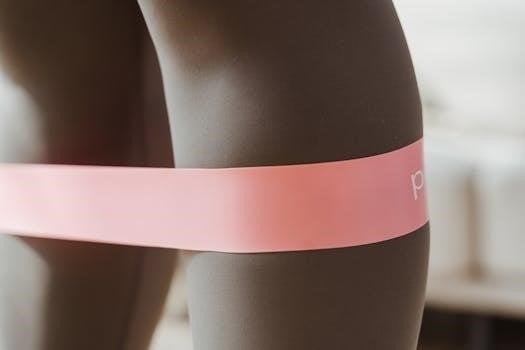
Iliotibial (IT) Band Syndrome (ITBS) is a common overuse injury. It primarily affects runners‚ cyclists‚ and hikers. ITBS causes pain along the outer thigh and knee due to IT band friction. Targeted stretches can provide relief.
Understanding IT Band Syndrome
IT Band Syndrome involves the iliotibial tract‚ a thick band of tissue from hip to shinbone. Overuse and repetitive movements cause irritation and inflammation. This leads to pain and discomfort‚ particularly during physical activities;
Definition and Causes of ITBS
Iliotibial Band Syndrome (ITBS)‚ also known as IT band syndrome‚ is an overuse injury. It is characterized by pain on the outside of the knee and thigh. The iliotibial band is a thick band of connective tissue. It runs from the hip down the outer thigh to the knee. ITBS occurs when this band becomes tight‚ irritated‚ or inflamed. This leads to friction as it rubs against the bony prominence of the femur (thighbone) at the knee.
Several factors contribute to the development of ITBS. These include repetitive movements such as running or cycling‚ especially over long distances. Inadequate stretching and warm-up routines can also increase the risk. Other causes are muscle imbalances‚ particularly weakness in the hip abductors‚ and improper training techniques. Furthermore‚ anatomical factors like leg length discrepancies or excessive pronation of the foot can also contribute to ITBS.
Symptoms of IT Band Syndrome
The primary symptom of IT Band Syndrome is pain on the lateral (outer) side of the knee. This pain is often described as sharp‚ burning‚ or aching. It typically worsens with activity‚ such as running‚ cycling‚ or walking. In some cases‚ the pain may radiate up the thigh towards the hip. The pain might be more intense when going up or down stairs‚ or when running downhill.
Other symptoms can include tenderness to the touch along the IT band near the knee. Some individuals may experience a clicking or popping sensation at the knee. Stiffness in the knee is also a common complaint‚ particularly after periods of rest. In severe cases‚ swelling may be present around the outer knee area. It’s crucial to note that symptoms can vary in intensity from mild discomfort to severe pain that limits activity. Early recognition and management of these symptoms are key to preventing chronic issues.

The Role of Stretching in ITBS Treatment
Stretching plays a vital role in managing IT Band Syndrome by addressing tightness. Regular stretching improves flexibility. It also supports healing. This helps reduce pain and improves overall function.
Why Stretching is Important
Stretching is a critical component in the treatment of Iliotibial Band Syndrome (ITBS). ITBS causes pain and inflammation due to a tight IT band rubbing against the femur. Regular stretching helps to alleviate this tightness‚ reducing friction and pain. A dedicated stretching routine improves flexibility in the muscles surrounding the IT band‚ such as the gluteus maximus‚ tensor fasciae latae (TFL)‚ and outer quadriceps. This enhanced flexibility can prevent future flare-ups by maintaining optimal muscle balance and reducing stress on the IT band. Consistent stretching contributes to improved hip mobility and overall lower body function. Stretching should be incorporated as a regular practice.
Common Misconceptions about Stretching the IT Band
A prevalent misconception is that the IT band itself can be directly stretched like a muscle. The IT band is a thick‚ fibrous tissue‚ making it difficult to significantly lengthen through stretching. While attempting to stretch the IT band directly may provide temporary relief‚ it’s more effective to focus on stretching the muscles that attach to it. These muscles include the gluteus maximus and tensor fasciae latae (TFL). Another misconception is that aggressive stretching will quickly resolve ITBS. Overstretching can cause further irritation and inflammation. It is important to approach stretching gently and consistently‚ focusing on gradual improvements in flexibility. Understanding these misconceptions can lead to a more effective and safer approach to managing ITBS.

Effective IT Band Stretches
Several stretches can alleviate IT band tightness. These stretches target the surrounding muscles‚ reducing tension. Consistent stretching aids in recovery and prevents future IT band issues. Examples include standing and wall stretches.
Standing IT Band Stretch
The standing IT band stretch is a fundamental exercise. It directly targets tightness in the iliotibial band. Stand straight and cross your affected leg in front of your other leg. Raise the arm opposite your affected leg overhead. Lean to the side away from the leg you crossed over. You should feel a stretch along the outside of your hip. Hold onto a chair or wall for balance‚ if needed. Maintain the stretch for at least 1 minute. Over time‚ try to lengthen the hold to 6 minutes. Repeat two to four times daily. Remember to repeat with your other leg. This stretch promotes flexibility. It also relieves tension associated with IT band syndrome.
Wall Supported IT Band Stretch
The wall-supported IT band stretch is an effective way to target the IT band. Stand a few inches from a wall‚ with your affected hip closest. Place your forearm against the wall for support. Cross your outside leg behind your inside leg. Gently lean your hip toward the wall. You should feel a stretch along the outside of your hip and thigh. Ensure that you maintain a straight posture and engage your core. Hold the stretch for at least 30 seconds‚ gradually increasing to 1 minute. Repeat this stretch 2-4 times on each side. This stretch provides a deeper‚ more focused stretch to the IT band. It can significantly improve flexibility and reduce pain.
Seated IT Band Stretch Variations
Seated IT band stretch variations offer a gentler approach. Sit on the floor with your legs extended. Cross the affected leg over the other. Gently twist your torso toward the affected side. For a deeper stretch‚ hug your bent knee or place the opposite hand on the floor behind you. Maintain a straight back and engage your core. You should feel a stretch along the outside of your hip and thigh. Hold the stretch for 20-30 seconds. Repeat 2-3 times. Another variation involves bending the non-affected leg and pulling the affected knee towards your chest while twisting. These seated stretches are ideal for those with limited mobility or recovering from acute pain. Always listen to your body and stop if you feel any sharp pain.

Additional Exercises for ITBS Recovery
Beyond stretching‚ recovery involves strengthening hips and using foam rolling. Hip exercises improve stability‚ while foam rolling addresses muscle tightness. This combination aids in comprehensive ITBS management and prevents recurrence.
Hip Strengthening Exercises
Weak hips often contribute to ITBS. Strengthening them is crucial for recovery and prevention. Focus on exercises that target the gluteus medius and maximus‚ which stabilize the pelvis and control leg movement. Examples include side-lying leg raises‚ hip abduction exercises with resistance bands‚ and glute bridges.
Incorporate clam shells‚ ensuring proper form to isolate the glutes. Single-leg squats‚ performed with control and a focus on maintaining pelvic stability‚ further enhance hip strength. These exercises correct imbalances that lead to IT band tightness and friction. Regular practice promotes proper biomechanics‚ reducing strain on the IT band. Consistent hip strengthening is a cornerstone of ITBS rehabilitation‚ aiding long-term recovery and injury prevention by addressing underlying weaknesses. Remember to start slowly and gradually increase the intensity and resistance as your strength improves.
Foam Rolling Techniques
Foam rolling can help release tension in the muscles surrounding the IT band. While it doesn’t directly stretch the IT band itself‚ it can improve flexibility in the quads‚ hamstrings‚ and glutes. Focus on these muscle groups to reduce overall tightness and indirectly alleviate IT band stress. Gently roll along the outer thigh‚ pausing on tender spots to allow for tissue release.
Use controlled movements and avoid excessive pressure‚ especially directly on the bony prominence of the knee. Incorporate foam rolling into your warm-up or cool-down routine. Spend several minutes on each muscle group‚ paying attention to areas of tightness. Remember‚ foam rolling should be mildly uncomfortable but not intensely painful. Consistency is key; regular foam rolling can contribute to improved muscle flexibility and reduced IT band friction‚ complementing other ITBS treatment strategies. Proper technique enhances effectiveness and minimizes discomfort during the process.

Considerations Before Starting Exercises
Before starting any exercises for ITBS‚ assess your pain levels. Begin slowly‚ and stop if pain increases. Warm-up and cool-down are also very important for a safe and effective recovery.
Assessing Pain Levels
Prior to commencing any exercise regimen for Iliotibial Band Syndrome (ITBS)‚ a thorough self-assessment of your current pain level is paramount; It’s crucial to understand your body’s signals to prevent further aggravation of the condition. Begin by identifying the specific location and intensity of your pain. Is it a sharp‚ stabbing sensation‚ or a dull ache? Rate your pain on a scale of 0 to 10‚ where 0 represents no pain and 10 represents the worst pain imaginable.
This baseline assessment will serve as a reference point throughout your exercise program. As you perform each stretch or exercise‚ pay close attention to how your pain level changes. A slight increase in discomfort may be acceptable‚ especially as you begin to work on tight muscles. However‚ any sharp‚ intense pain should be a signal to stop immediately.
Remember‚ the goal is to gradually improve your condition‚ not to push through pain and risk further injury. Regular monitoring of your pain levels will help you tailor your exercise program to your individual needs and ensure a safe and effective recovery.
Importance of Warm-up and Cool-down
Incorporating a proper warm-up and cool-down routine into your ITBS exercise plan is essential for both preventing injury and maximizing recovery. A warm-up prepares your muscles for the upcoming activity by gradually increasing blood flow and flexibility. This reduces the risk of strains and tears‚ particularly in the IT band and surrounding tissues. A light cardio activity‚ such as walking or cycling‚ for five to ten minutes followed by gentle dynamic stretches is ideal.
Conversely‚ a cool-down helps your body transition back to a resting state after exercise. It promotes muscle recovery by flushing out metabolic waste products and reducing muscle soreness. Gentle static stretches‚ holding each stretch for 30 seconds‚ are perfect for a cool-down.
Skipping the warm-up or cool-down can negate the benefits of your ITBS stretches and exercises‚ potentially leading to increased pain and a prolonged recovery. Therefore‚ always prioritize these crucial components for a safe and effective rehabilitation process.
Effective management of Iliotibial Band Syndrome requires a comprehensive approach‚ integrating various strategies to address both the symptoms and underlying causes. Stretching‚ as highlighted‚ plays a crucial role in alleviating IT band tightness and improving flexibility. However‚ it’s vital to remember that stretching alone may not be sufficient for complete recovery. Strengthening exercises‚ particularly targeting the hip abductors and glutes‚ are equally important to stabilize the pelvis and prevent future imbalances.
Furthermore‚ addressing training errors‚ such as excessive mileage or inadequate warm-up routines‚ is crucial for long-term prevention. Foam rolling can also be incorporated to release muscle tension.
Ultimately‚ a holistic approach that combines targeted exercises‚ proper training techniques‚ and addressing biomechanical factors provides the best chance for successful ITBS management and a return to pain-free activity. Consulting with a physical therapist or healthcare professional can help tailor a specific plan to your individual needs and ensure a safe and effective recovery.